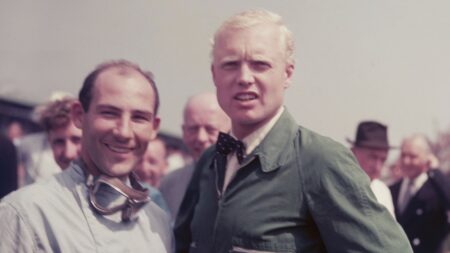
The Heroes of Jaguar
Stirling’s C-Change The Jaguar C-type was the car that pioneered disc brake technology in 1952, when a young Stirling Moss was its driver. We reunited them at Silverstone Read now…
Getty Images
Sportscar fans tend to get dewy-eyed when they look back to the 1980s as the decade brought Group C with its bumper fields of Porsche 956s, then 962s. Armed with equal machinery, privateer teams were able to take it to the works team. Then, as the decade came to a close, there was a glorious explosion of cars from rival manufacturers, as Mercedes, Toyota and, most notably, Jaguar went for gold.
The first race of the decade was very different, though, as the World Championship for Makes fought for traction. It was Porsche 935 versus the fragile Lancias, but the storybook gained a unique entry when Jean Rondeau won in a car bearing his own name. What changed after this was a considerable sorting out of the rulebook, with Group C being formulated in 1981 as a step towards rationalising a class structure that included no fewer than 10 categories. For 1982, there would be a reduction to six classes for Le Mans and the Group C ranks exploded from two WMs in 1981 to 28 cars in the top class. However, when the Porsche 956 broke cover at that Silverstone 6 Hours, the drivers hated it, with Derek Bell loathing the way they had to pussyfoot around to save enough fuel to finish, lapping 10sec off the pace. This simply wasn’t what he thought of as racing. And yet, it was the start of something special and he and team-mate Jacky Ickx followed up their Le Mans victory in a Porsche 936 in 1981 with another in the 956, with the other works 956s second and third.
With Porsche releasing 956s to customer teams plus the introduction of Group C Junior (later C2), the ACO had so many entries in 1983 that it could slim the format down from seven classes to three. Porsche dominated, although Al Holbert’s leading 956 had its engine cut out at the start of the final lap, then fire again so that he could hold off Bell to win.
The ACO’s decision in 1984 to admit IMSA-spec cars and raise the weight of Group C cars by 50kg led to the works Porsches being withdrawn. Fortunately for Porsche, there were 16 privately-entered 956s and Henri Pescarolo and Klaus Ludwig outraced the works Lancias to win for the Joest team. It won again in 1985, this time beating the works team.
Porsche knew that a more serious challenge than the Lancias would be coming. A Group 44 Jaguar had won the IMSA GTP class in 1985, then in 1986 a three-car TWR-run team was Jaguar’s first works offering since 1955. Porsche won again, with none of the Jaguars finishing. For 1987, though, having won the first four races of the year, Jaguar arrived at Le Mans expecting victory and left with only fifth place as Bell, Holbert and Hans Stuck won for Porsche. Then, in 1988, the thousands of Jaguar fans were rewarded, but only just, with Jan Lammers nursing the winning XJR9 through the final 40 minutes, including a pitstop, stuck in fourth gear.
A footnote was that the French WM team finally achieved its aim of exceeding 400kph on the Mulsanne, with Roger Dorchy hitting 405kph in the cool of the evening. There was to be no Jaguar follow-up. The first two cars home in 1989 were from Mercedes, its cars run by Sauber and it was a first win for the Silver Arrows since 1952.